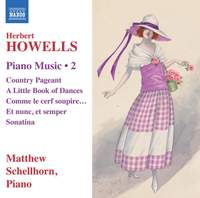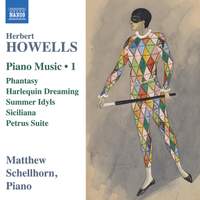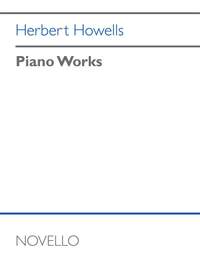Interview,
Matthew Schellhorn on the piano music of Herbert Howells
 Now into its second volume, Matthew Schellhorn's series of recordings of the piano music of Herbert Howells is shining a welcome spotlight on a rarely-heard aspect of a composer generally associated with choral music. Though composition for the piano was never a primary focus for Howells, it remained a constant presence in his musical life and work, and his piano pieces trace the trajectory from his youthful style into the kind of harmonic language encountered in his better-known works.
Now into its second volume, Matthew Schellhorn's series of recordings of the piano music of Herbert Howells is shining a welcome spotlight on a rarely-heard aspect of a composer generally associated with choral music. Though composition for the piano was never a primary focus for Howells, it remained a constant presence in his musical life and work, and his piano pieces trace the trajectory from his youthful style into the kind of harmonic language encountered in his better-known works.
I spoke to Matthew about these works, and in particular the somewhat protean history of the Sonatina.
The majority of these recordings are world premieres; where have these pieces been hiding in the decades since Howells’s death?
This volume presents more posthumously published piano music alongside works that Howells allowed to be released during his lifetime. I am fortunately the first to record 16 of the 17 works featured, including 7 that come from the award-winning Novello score edited by British music scholar Dr Jonathan Clinch – works from 1908 (Comme le cerf soupire..., The Arab’s Song, To a Wild Flower, Romance, Melody, Legend, Minuet for Ursula), when Howells was a teenager and already a gifted composer, through to 1935 by which time he was an established teacher. There are also world premiere recordings of occasional works published at the time but no longer available in print (A Mersey Tune, A Sailor Tune, Three Tunes, Promenade for Girls and Promenade for Boys). I also present first complete recordings of better-known series (Country Pageant, A Little Book of Dances), a piece that was in private hands and only turned up late in the process (Et nunc, et semper), and my own version of the most well-known and best-established piano work by Howells, the Sonatina, of which I was lucky to be able to see the various manuscripts.
The earlier works dating from the 1900s are distinctly different in their harmonic language from the style more commonly associated with Howells. Is there a point where you feel the “real Howells” emerges, or is it all real Howells?
The issue of Howells’s stylistic development is absolutely fascinating and, as Howells grows in recognition as a prodigious and profound piano writer, is of immense musicological and artistic importance. I have found, in preparing such a vast amount of material for performance and recording, that there are stylistic traits common to all ‘eras’ in Howells’s life – a fascination with melody, an almost visionary attitude towards harmonic mode, and the most inventive approach to form breaking the perceived boundaries first of the Romantic era and then of the modern age. What seems to take place is an intensification of all these areas, but the essential character remains present. To see this music with a wider perspective than formerly possible showed me some truly astonishing resonances throughout the composer’s life: as an example, a small melodic fragment outlined towards the recapitulation of To a Wild Flower of 1908 becomes the opening motif of the Sonatina published in 1971. The main point here is that by presenting the youthful, seemingly naïve offerings of the composer – and much of Howells’s piano output was unashamedly written for an educational purpose – we can best perceive Howells’s stylistic and very personal journey.
You comment on the ever-changing nature of the Sonatina – numerous different versions and variants. It sounds like you had to take on the role of an editor as well as a performer before recording it – how did you approach settling on a single incarnation of the Sonatina to include?
The Sonatina was a work I had performed before but several corners in the published version particularly fascinated me for pianistic and expressive reasons and so it was very helpful to check the original manuscript notation. As I did so, I realised there was an intense internal debate for Howells about nearly all the main material, indicated by the many different versions and iterative notational process, so I decided to learn all the many versions and allow a dynamic editorial process to take place based on remaining true to the endorsed public version while allowing audiences to sample some of the options Howells allowed to be performed (in the early performance premiering process). For many months, I thought of little else at the piano, running the variants over and over in various combinations. I also visited the British Library to listen to early BBC broadcast performances at which Howells was present, from which I was able to deduce the date and intellectual impetus behind the material. I also spoke about my ideas to the dedicatee, Hilary Macnamara, who, having participated in my thought processes, offered her response to what material might or might not be included, along with other interpretative elements such as tempi and even small details like the relative characteristics of articulations and accents. What emerges is a freshly voiced re-presentation of this beautiful and exciting work, which I hope will stimulate other musicians and audiences.
How much Howells for the piano is still out there – and are you planning to continue recording it?
In essence, Howells as a piano composer has been unjustly neglected, and this series hopes to challenge perceptions about not only his own oeuvre but also British music in general. In fact, there are further unrecorded and out-of-print works to explore, along with established keyboard repertoire, which, again, helps to colour the picture of this distinctive composer. As with volume 1, people have listened to Howells’s piano music and then written to me asking when the next album will come out! It is all immensely exciting.
Matthew Schellhorn (piano)
Available Formats: CD, MP3, FLAC, Hi-Res FLAC
Matthew Schellhorn (piano)
Available Formats: CD, MP3, FLAC, Hi-Res FLAC
This collection of fifteen pieces, transcribed and edited by the Howells scholar Jonathan Clinch, and published for the first time to coincide with Matthew Schellhorn’s recording, reveals a previously neglected aspect of the composer. The pieces chart Howells's musical development, from his earliest known work The Arab’s Song, written when he was 16, to the Petrus Suite, completed in his eighties, as well as demonstrating his fascination with French music and the Tudor period.
Available Format: Sheet Music





